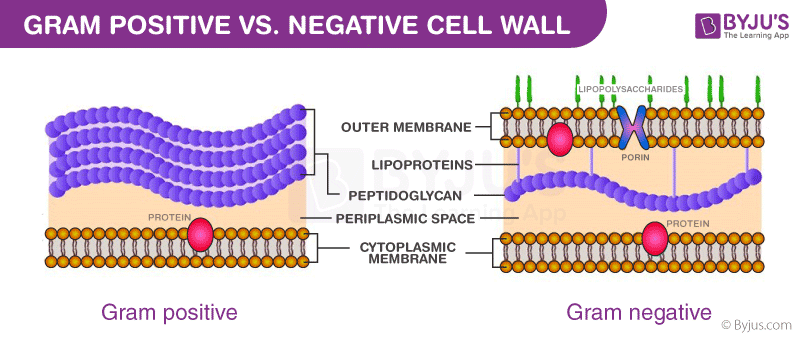The outer cell layer or cell envelope has two major components – a rigid cell wall and an underlying plasma membrane. Here, let’s learn the functions and composition of a bacterial cell wall.
Table of Contents
- Bacterial Cell Wall and Its Functions
- Components of Bacterial Cell Wall
- Defective Bacterial Cell Wall
- Frequently Asked Questions
Bacterial Cell Wall and Its Functions
The bacterium is surrounded by a strong, rigid cell wall. The cell wall gives bacteria stiffness and determines the form of the cell. It is a component of cell division. The cell wall also offers a defence against osmotic damage to the cell.
The bacterial cell wall has lysozymes, bacteriophages, and antibiotic target sites. It transports antigens from the bacteria that are vital to virulence and immunity.
Components of Bacterial Cell Wall
The peptidoglycan that makes up the rigid portion of the cell wall is called murein and is made up of N-acetyl glucosamine and N-acetylmuramic acid molecules that alternate in chains and are cross-connected by peptide subunits. Gram-positive bacteria have simpler chemical structures in their cell walls than Gram-negative bacteria.
Gram-negative Cell Wall
The gram-negative cell wall has the following components:
- Thin peptidoglycan layer – Peptidoglycan is a polymer of sugar and amino acids and is often single-layered in the gram-negative cell wall.
- Outer membrane – It is a protein layer that acts as a target site for antibiotics and phages.
- Lipoprotein layer – Links the peptidoglycan to the outer cell membrane.
- Lipopolysaccharide – It constitutes the endotoxicity of gram-negative bacteria. The toxicity is associated with the lipid A molecule of the lipopolysaccharide.
- Periplasmic space – It is the space between the outer and inner membranes.
Gram-positive Cell Wall
The gram-positive cell wall has the following components:
- Thick or multilayered peptidoglycan. It provides structural strength and mechanical rigidity.
- Teichoic acid – It is a water-soluble polymer that constitutes the major surface antigens of gram-positive bacteria.
It lacks an outer membrane and lipopolysaccharide but has other components such as polysaccharides and proteins.

Explore: Difference between Gram-positive and Negative Cell Wall
Defective Bacterial Cell Wall
Antibiotics, lysozymes and bacteriophages are just a few examples of the many substances that can hinder or interfere with the formation of cell walls. There are four categories of bacteria that lack or have deficient cell walls.
- L-forms – It is a growth form of bacteria that has no cell wall. Murein or peptidoglycan is absent. L-forms develop when agents like penicillin interfere with the formation of cell walls.
- Mycoplasma – They are naturally occurring bacteria that lack a cell wall. These are classified under an independent genus.
- Spheroplasts – It is a bacterial cell whose cell wall has been nearly or totally destroyed due to the actions of lysozyme or penicillin. It is usually derived from gram-negative bacteria.
- Protoplasts – The term refers to the whole cell, excluding the cell wall. Spheroplasts and protoplasts are different from one another as in the latter, the cell wall has been entirely removed. It is usually derived from gram-positive bacteria.
Keep exploring BYJU’S Biology to learn more such exciting topics.
See more: